Lithological Classification Using ZY1-02D Hyperspectral Data by Means of Machine Learning and Deep Learning Methods in the Kohat–Pothohar Plateau, Khyber Pakhtunkhwa, Pakistan
Abstract
1. Introduction
2. Geological Background
3. Materials and Methods
3.1. Hyperspectral Images
3.2. Field Validation
3.3. Hyperspectral Data Preprocessing
3.4. Spectral Feature Identification
3.5. False Color Composite of Surface Reflectance
3.6. Principal Component Analysis (PCA)
3.7. Support Vector Machine
3.8. Spatial–Spectral Transformer (SSTF)
3.8.1. Data Augmentation: Spectral Noise, Spatial Rotation, and Band Dropping
- Spectral noise: adding noise to the spectral bands simulates real-world scenarios where hyperspectral data may contain noise due to sensor limitations or environmental conditions.
- 2.
- Spatial rotation: rotating the spatial dimensions of the hyperspectral data simulates variations in orientation that might occur during data acquisition.
- 3.
- Band dropping: band dropping randomly removes certain spectral bands to simulate scenarios where specific wavelengths may be missing or corrupted, ensuring the model learns to handle incomplete data.
3.8.2. Combined Effect
3.9. Accuracy Assessment
4. Results
4.1. False Color Composite of Surface Reflectance
4.2. Principal Component Analysis (PCA)
4.3. Support Vector Machine
4.4. Spatial–Spectral Transformer (SSTF)
4.5. Field Validation
4.6. Relationships Between the Laboratory-Measured Spectra and the Image Spectra
5. Discussion
6. Conclusions
Author Contributions
Funding
Data Availability Statement
Conflicts of Interest
References
- Liu, H.; Zhang, H.; Yang, R. Lithological Classification by Hyperspectral Remote Sensing Images Based on Double-Branch Multi-Scale Dual-Attention Network. IEEE J. Sel. Top. Appl. Earth Obs. Remote Sens. 2024, 17, 14726–14741. [Google Scholar] [CrossRef]
- Lin, N.; Fu, J.; Jiang, R.; Li, G.; Yang, Q. Lithological Classification by Hyperspectral Images Based on a Two-Layer XGBoost Model, Combined with a Greedy Algorithm. Remote Sens. 2023, 15, 3764. [Google Scholar] [CrossRef]
- Zhang, Y.; Pan, W.; Yu, Z. Application of GF-5 hyperspectral data in uranium exploration: A case study of Weijing in Inner Mongolia, China. In Ninth Symposium on Novel Photoelectronic Detection Technology and Applications; SPIE: Bellingham, WA, USA, 2023; Volume 12617, pp. 758–769. [Google Scholar]
- Zhang, C.; Yi, M.; Ye, F.; Xu, Q.; Li, X.; Gan, Q. Application and Evaluation of Deep Neural Networks for Airborne Hyperspectral Remote Sensing Mineral Mapping: A Case Study of the Baiyanghe Uranium Deposit in Northwestern Xinjiang, China. Remote Sens. 2022, 14, 5122. [Google Scholar] [CrossRef]
- Kumar, C.; Chatterjee, S.; Oommen, T.; Guha, A. Automated lithological mapping by integrating spectral enhancement techniques and machine learning algorithms using AVIRIS-NG hyperspectral data in Gold-bearing granite-greenstone rocks in Hutti, India. Int. J. Appl. Earth Obs. Geoinf. 2020, 86, 102006. [Google Scholar] [CrossRef]
- Chen, L.; Zhang, N.; Zhao, T.; Zhang, H.; Chang, J.; Tao, J.; Chi, Y. Lithium-Bearing Pegmatite Identification, Based on Spectral Analysis and Machine Learning: A Case Study of the Dahongliutan Area, NW China. Remote Sens. 2023, 15, 493. [Google Scholar] [CrossRef]
- Shebl, A.; Abriha, D.; Fahil, A.S.; El-Dokouny, H.A.; Elrasheed, A.A.; Csámer, Á. PRISMA hyperspectral data for lithological mapping in the Egyptian Eastern Desert: Evaluating the support vector machine, random forest, and XG boost machine learning algorithms. Ore Geol. Rev. 2023, 161, 105652. [Google Scholar] [CrossRef]
- Liu, H.; Wu, K.; Xu, H.; Xu, Y. Lithology Classification using TASI thermal infrared hyperspectral data with convolutional neural networks. Remote Sens. 2021, 13, 3117. [Google Scholar] [CrossRef]
- Yu, J.; Zhang, L.; Li, Q.; Li, Y.; Huang, W.; Sun, Z.; Ma, Y.; He, P. 3D autoencoder algorithm for lithological mapping using ZY-1 02D hyperspectral imagery: A case study of Liuyuan region. J. Appl. Remote Sens. 2021, 15, 042610. [Google Scholar] [CrossRef]
- Di Tommaso, I.; Rubinstein, N. Hydrothermal alteration mapping using ASTER data in the Infiernillo porphyry deposit, Argentina. Ore Geol. Rev. 2007, 32, 275–290. [Google Scholar] [CrossRef]
- Alimohammadi, M.; Alirezaei, S.; Kontak, D.J. Application of ASTER data for exploration of porphyry copper deposits: A case study of Daraloo–Sarmeshk area, southern part of the Kerman copper belt, Iran. Ore Geol. Rev. 2015, 70, 290–304. [Google Scholar] [CrossRef]
- Moghtaderi, A.; Moore, F.; Ranjbar, H. Application of ASTER and Landsat 8 imagery data and mathematical evaluation method in detecting iron minerals contamination in the Chadormalu iron mine area, central Iran. J. Appl. Remote Sens. 2017, 11, 16027. [Google Scholar] [CrossRef]
- Liu, L.; Yin, C.; Khalil, Y.S.; Hong, J.; Feng, J.; Zhang, H. Alteration Mapping for Porphyry Cu Targeting in the Western Chagai Belt, Pakistan, Using ZY1-02D Spaceborne Hyperspectral Data. Econ. Geol. 2024, 119, 331–353. [Google Scholar] [CrossRef]
- Islam, N.U.; Zhang, Q.; Qiu, W.; Liu, L.; Khalil, Y.S.; Ahmad, S.M.; Ahmad, W. Mineralogical Mapping and Lithological Discrimination by Using ASTER Remote Sensing Data in the Chitral Region, Khyber Pakhtunkhwa, Northern Pakistan. Earth Sci. Inform. 2024, 17, 6075–6094. [Google Scholar] [CrossRef]
- Hook, S.J.; Dmochowski, J.E.; Howard, K.A.; Rowan, L.C.; Karlstrom, K.E.; Stock, J.M. Mapping variations in weight percent silica measured from multispectral thermal infrared imagery—Examples from the Hiller Mountains, Nevada, USA and Tres Virgenes-La Reforma, Baja California Sur, Mexico. Remote Sens. Environ. 2005, 95, 273–289. [Google Scholar] [CrossRef]
- Pour, A.B.; Hashim, M. The application of ASTER remote sensing data to porphyry copper and epithermal gold deposits. Ore Geol. Rev. 2012, 44, 1–9. [Google Scholar] [CrossRef]
- Baid, S.; Tabit, A.; Algouti, A.; Algouti, A.; Nafouri, I.; Souddi, S.; Aboulfaraj, A.; Ezzahzi, S.; Elghouat, A. Lithological discrimination and mineralogical mapping using Landsat-8 OLI and ASTER remote sensing data: Igoudrane region, jbel saghro, Anti Atlas, Morocco. Heliyon 2023, 9, e17363. [Google Scholar] [CrossRef]
- Crósta, A.P.; MOORE, J.M. Geological mapping using landsat thematic mapper imagery in almeria province, South-East Spain. Int. J. Remote Sens. 1989, 10, 505–514. [Google Scholar] [CrossRef]
- Zhong, Y.; Wang, X.; Wang, S.; Zhang, L. Advances in spaceborne hyperspectral remote sensing in China. Geo-Spat. Inf. Sci. 2021, 24, 95–120. [Google Scholar] [CrossRef]
- Pivnik, D.A.; Wells, N.A. The transition from Tethys to the Himalaya as recorded in northwest Pakistan. GSA Bull. 1996, 108, 1295–1313. [Google Scholar] [CrossRef]
- Kazmi, A.H.; Rana, R.A. Map Showing Structural Features and Tectonic Stages in Pakistan; Geological Survey of Pakistan: Islamabad, Pakistan, 1982. [Google Scholar]
- Meissner, C.R.; Master, J.M.; Rashid, M.A.; Hussain, M. Stratigraphy of the Kohat Quadrangle, Pakistan; U.S. Government Publishing Office: Washington, DC, USA, 1974. [Google Scholar]
- Abbasi, I.A.; McElroy, R. Thrust kinematics in the Kohat Plateau, Trans Indus Range, Pakistan. J. Struct. Geol. 1991, 13, 319–327. [Google Scholar] [CrossRef]
- Sajjad, A. A Comparative Study of Structural Styles in the Kohat Plateau, NW Himalayas, NWFP, Pakistan. Doctoral Dissertation, University of Peshawar, Peshawar, Pakistan, 2003. [Google Scholar]
- Ahmad, S.; Ali, F.; Khan, M.I.; Khan, A.A. Structural Transect of the Western Kohat Fold and Thrust Belt between Hangu and Basia Khel, N.W.F.P., Pakistan. Pak. J. Hydrocarb. Res. 2006, 16, 23–35. [Google Scholar]
- Paracha, W. Kohat Plateau with Reference to Himalayan Tectonic General Study. CSEG Recorder 2004, 29, 126–134. [Google Scholar]
- Suliman, M.; Ali, M.; Faisal, S. Lithological mapping of northern Kohat Plateau’s limestone outcrops using integrated remote sensing and reflectance spectroscopy techniques. Geol. Ecol. Landsc. 2023, 1–14. [Google Scholar] [CrossRef]
- Ahmad, Z. Mineral Directory of Pakistan; Geological Survey of Pakistan: Peshawar, Pakistan, 1969; Volume 15, pp. 1–200. [Google Scholar]
- Shah, S.I. Stratigraphy of Pakistan: Geological Survey of Pakistan Memoir; Geological Survey of Pakistan: Peshawar, Pakistan, 1977; Volume 12, 138p. [Google Scholar]
- Nagmah, R. Mineral Resources of Pakistan: A Review; Geological Survey of Pakistan: Peshawar, Pakistan, 2016; Volume 128. [Google Scholar]
- Acharya, P.K.; Berk, A.; Anderson, G.P.; Larsen, N.F.; Tsay, S.C.; Stamnes, K.H. MODTRAN4: Multiple Scattering and Bi-Directional Reflectance Distribution Function (BRDF) Upgrades to MODTRAN. 1998. Available online: http://www.spectral.com (accessed on 19 October 2024).
- Mars, J.C. Mineral and lithologic mapping capability of worldview 3 data at Mountain Pass, California, using true- and false-color composite images, band ratios, and logical operator algorithms. Econ. Geol. 2018, 113, 1587–1601. [Google Scholar] [CrossRef]
- Yilmaz, O.S.O. SNR Analysis of a Spaceborne Hyperspectral Imager. In Proceedings of the 2013 6th International Conference on Recent Advances in Space Technologies (RAST), Istanbul, Turkey, 12–14 June 2013; IEEE: Piscataway, NJ, USA, 2013. [Google Scholar]
- Baldridge, A.M.; Hook, S.J.; Grove, C.I.; Rivera, G. The ASTER Spectral Library Version 2.0. Remote Sens. Environ. 2009, 113, 711–715. [Google Scholar] [CrossRef]
- Islam, N.U.; Lei, L.; Khalil, Y.S.; Ahmad, S.M.; Ullah, I. Mapping Alteration Zones for Detection of Economic Minerals Using Integrated Tools in District Lower Dir, Northwest Khyber Pakhtunkhwa, Pakistan. 2023. Available online: www.econ-environ-geol.org (accessed on 24 September 2024).
- Hunt, G.R.; Ashley, R.P. Spectra of Altered Rocks in the Visible and Near Infrared. Econ. Geol. 1979, 74, 1613–1629. [Google Scholar] [CrossRef]
- Hunt, G.R. Spectral Signatures of Particulate Minerals in the Visible and Near Infrared. Geophysics 1977, 42, 501–513. [Google Scholar] [CrossRef]
- Richards, J.A.; Jia, X. Remote Sensing Digital Image Analysis: An Introduction; Springer: Berlin/Heidelberg, Germany, 2006. [Google Scholar] [CrossRef]
- Drury, S.A. Image Interpretation in Geology; Chapman & Hall: London, UK; New York, NY, USA, 1993. [Google Scholar]
- Chukwu, G.U.; Ijeh, B.I.; Olunwa, K.C. Application of Landsat imagery for landuse/landcover analyses in the Afikpo sub-basin of Ni-geria. Int. Res. J. Geol. Min. 2013, 3, 67–81. [Google Scholar]
- Sabins, F.F.; Ellis, J.M. Remote Sensing Principles, Interpretation, and Applications Lab Manual; Waveland Press: Long Grove, IL, USA, 1997. [Google Scholar]
- Bishta, A. Lithologic discrimination using selective image processing technique of landsat 7 Data, Um bogma environs westcentral sinai, egypt. J. King Abdulaziz Univ. Sci. 2009, 20, 193–213. [Google Scholar] [CrossRef]
- Ourhzif, Z.; Algouti, A.; Hadach, F. Lithological mapping using landsat 8 oli and aster multispectral data in imini-ounilla district south high atlas of marrakech. Int. Arch. Photogramm. Remote Sens. Spat. Inf. Sci.-ISPRS Arch. 2019, 1255–1262. [Google Scholar] [CrossRef]
- Pour, A.B.; Hashim, M. Hydrothermal alteration mapping from Landsat-8 data, Sar Cheshmeh copper mining district, south-eastern Islamic Republic of Iran. J. Taibah Univ. Sci. 2015, 9, 155–166. [Google Scholar] [CrossRef]
- Jing, Q.C.L.; Panahi, A. Principal component analysis with optimum order sample correlation coefficient for image enhancement. Int. J. Remote Sens. 2006, 27, 3387–3401. [Google Scholar] [CrossRef]
- Crosta, A.P. Enhancement of Landsat Thematic Mapper Imagery for Residual Soil Mapping in SW Minas Gerais State, Brazil—A Prospecting Case History in Greenstone Belt Terrain. In Proceedings of the 7th Thematic Conference on Remote Sensing for Exploration Geology, Calgary, AB, Canada, 2–6 October 1989; pp. 1173–1187. [Google Scholar]
- Kruse, F.A.; Lefkoff, A.B.; Boardman, J.W.; Heidebrecht, K.B.; Shapiro, A.T.; Barloon, P.J.; Goetz, A.F.H. The Spectral Image Processing System (SIPS)—Interactive Visualization and Analysis of Imaging Spectrometer Data. Remote Sens. Environ. 1993, 44, 145–163. [Google Scholar] [CrossRef]
- Laben, C.A.; Brower, B.V. Process for Enhancing the Spatial Resolution of Multispectral Imagery Using Pan Sharpening. US Patent US 6,011,875, 4 January 2000. [Google Scholar]
- Loughlint, W.P. Principal Component Analysis for Alteration Mapping. Photogramm. Eng. Remote Sens. 1991, 57, 1163–1169. [Google Scholar]
- Cortes, C.; Vapnik, V.; Saitta, L. Support-Vector Networks Editor; Kluwer Academic Publishers: Dordrecht, The Netherlands, 1995. [Google Scholar]
- Tahmasebi, P.; Kamrava, S.; Bai, T.; Sahimi, M. Machine learning in geo- and environmental sciences: From small to large scale. Adv. Water Resour. 2020, 142, 103619. [Google Scholar] [CrossRef]
- Zhang, Z.; Yin, F.; Zhu, Y.; Liu, L. Lithologic Mapping in the Karamaili Ophiolite–Mélange Belt in Xinjiang, China, with Machine Learning and Integration of SDGSAT-1 TIS, Landsat-8 OLI and ASTER-GDEM. Nat. Resour. Res. 2025, 1–29. [Google Scholar] [CrossRef]
- Rezaei, A.; Hassani, H.; Moarefvand, P.; Golmohammadi, A. Lithological mapping in Sangan region in Northeast Iran using ASTER satellite data and image processing methods. Geol. Ecol. Landsc. 2019, 4, 59–70. [Google Scholar] [CrossRef]
- Hong, D.; Han, Z.; Yao, J.; Gao, L.; Zhang, B.; Plaza, A.; Chanussot, J. SpectralFormer: Rethinking Hyperspectral Image Classification with Transformers. IEEE Trans. Geosci. Remote Sens. 2021, 60, 5518615. [Google Scholar] [CrossRef]
- Ge, W.; Yang, X.; Jiang, R.; Shao, W.; Zhang, L. CD-CTFM: A Lightweight CNN-Transformer Network for Remote Sensing Cloud Detection Fusing Multiscale Features. IEEE J. Sel. Top. Appl. Earth Obs. Remote Sens. 2024, 17, 4538–4551. [Google Scholar] [CrossRef]
- Li, M.; Fu, Y.; Zhang, Y. Spatial-Spectral Transformer for Hyperspectral Image Denoising. arXiv 2022, arXiv:2211.14090. [Google Scholar] [CrossRef]
- Franke, M.; Degen, J. The softmax function: Properties, motivation, and interpretation. PsyArXiv 2023. [Google Scholar] [CrossRef]
- Kingma, D.P.; Ba, J.; Adam: A Method for Stochastic Optimization. December 2014. Available online: https://arxiv.org/abs/1412.6980 (accessed on 9 November 2024).
- Yin, C.; Long, Y.; Liu, L.; Khalil, Y.S.; Ye, S. Mapping Ni-Cu-Platinum Group Element-Hosting, Small-Sized, Mafic-Ultramafic Rocks Using WorldView-3 Images and a Spatial-Spectral Transformer Deep Learning Method. Econ. Geol. 2024, 119, 665–680. [Google Scholar] [CrossRef]
- Chang, R.; Lin, H.; Yang, W.; Ruan, R.; Liu, X.; Tian, H.-C.; Xu, J. Comparison of laboratory and in situ reflectance spectra of Chang’e-5 lunar soil. Astron. Astrophys. 2023, 674, A68. [Google Scholar] [CrossRef]
- Dufréchou, G.; Grandjean, G.; Bourguignon, A. Geometrical analysis of laboratory soil spectra in the short-wave infrared domain: Clay composition and estimation of the swelling potential. Geoderma 2015, 243–244, 92–107. [Google Scholar] [CrossRef]
- Karimzadeh, S.; Tangestani, M.H. Evaluating the VNIR-SWIR datasets of WorldView-3 for lithological mapping of a metamorphic-igneous terrain using support vector machine algorithm; a case study of Central Iran. Adv. Space Res. 2021, 68, 2421–2440. [Google Scholar] [CrossRef]
- Liu, L.; Zhou, J.; Han, L.; Xu, X. Mineral mapping and ore prospecting using Landsat TM and Hyperion data, Wushitala, Xinjiang, northwestern China. Ore Geol. Rev. 2017, 81, 280–295. [Google Scholar] [CrossRef]
- Nafigin, I.O.; Ishmukhametova, V.T.; Ustinov, S.A.; Minaev, V.A.; Petrov, V.A. Geological and Mineralogical Mapping Based on Statistical Methods of Remote Sensing Data Processing of Landsat-8: A Case Study in the Southeastern Transbaikalia, Russia. Sustainability 2022, 14, 9242. [Google Scholar] [CrossRef]
- Othman, A.A.; Gloaguen, R. Improving lithological mapping by SVM classification of spectral and morphological features: The discovery of a new chromite body in the Mawat Ophiolite Complex (Kurdistan, NE Iraq). Remote Sens. 2014, 6, 6867–6896. [Google Scholar] [CrossRef]
- Ma, Y.; Lan, Y.; Xie, Y.; Yu, L.; Chen, C.; Wu, Y.; Dai, X. A Spatial–Spectral Transformer for Hyperspectral Image Classification Based on Global Dependencies of Multi-Scale Features. Remote Sens. 2024, 16, 404. [Google Scholar] [CrossRef]
- Asran, A.M.; Hassan, S. Remote sensing-based geological mapping and petrogenesis of Wadi Khuda Precambrian rocks, South Eastern Desert of Egypt with emphasis on leucogranite. Egypt. J. Remote Sens. Space Sci. 2021, 24, 15–27. [Google Scholar] [CrossRef]

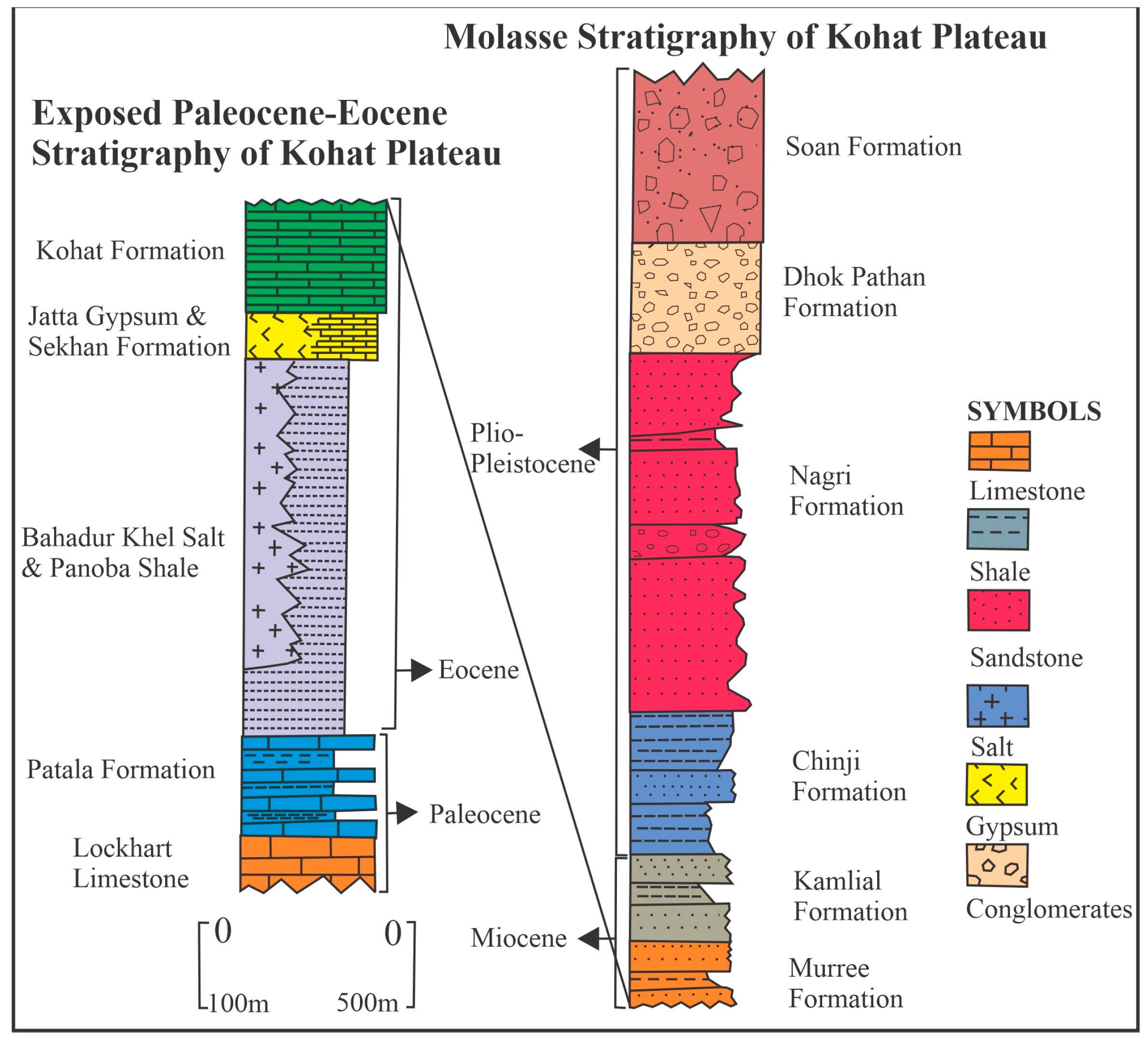

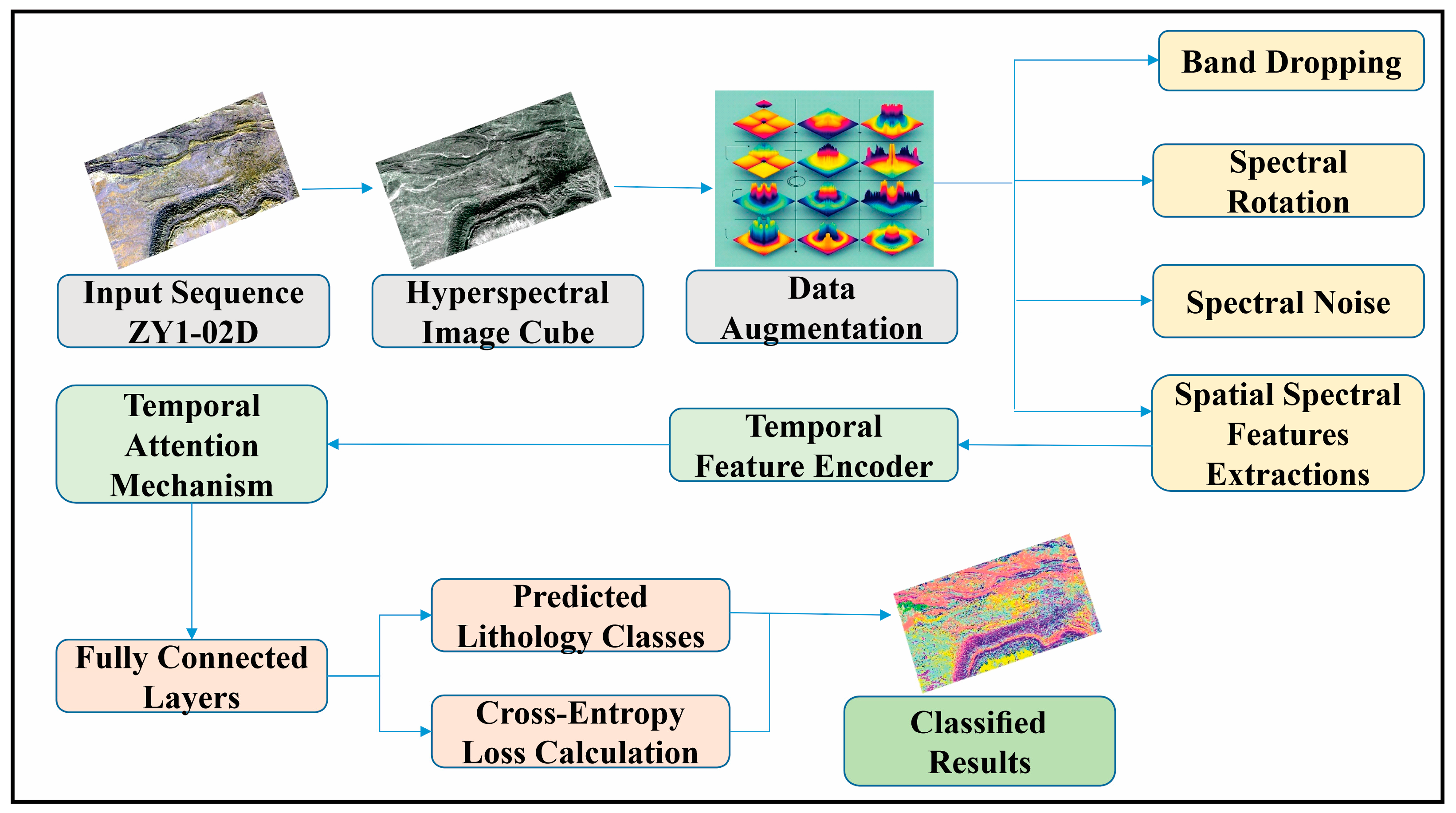

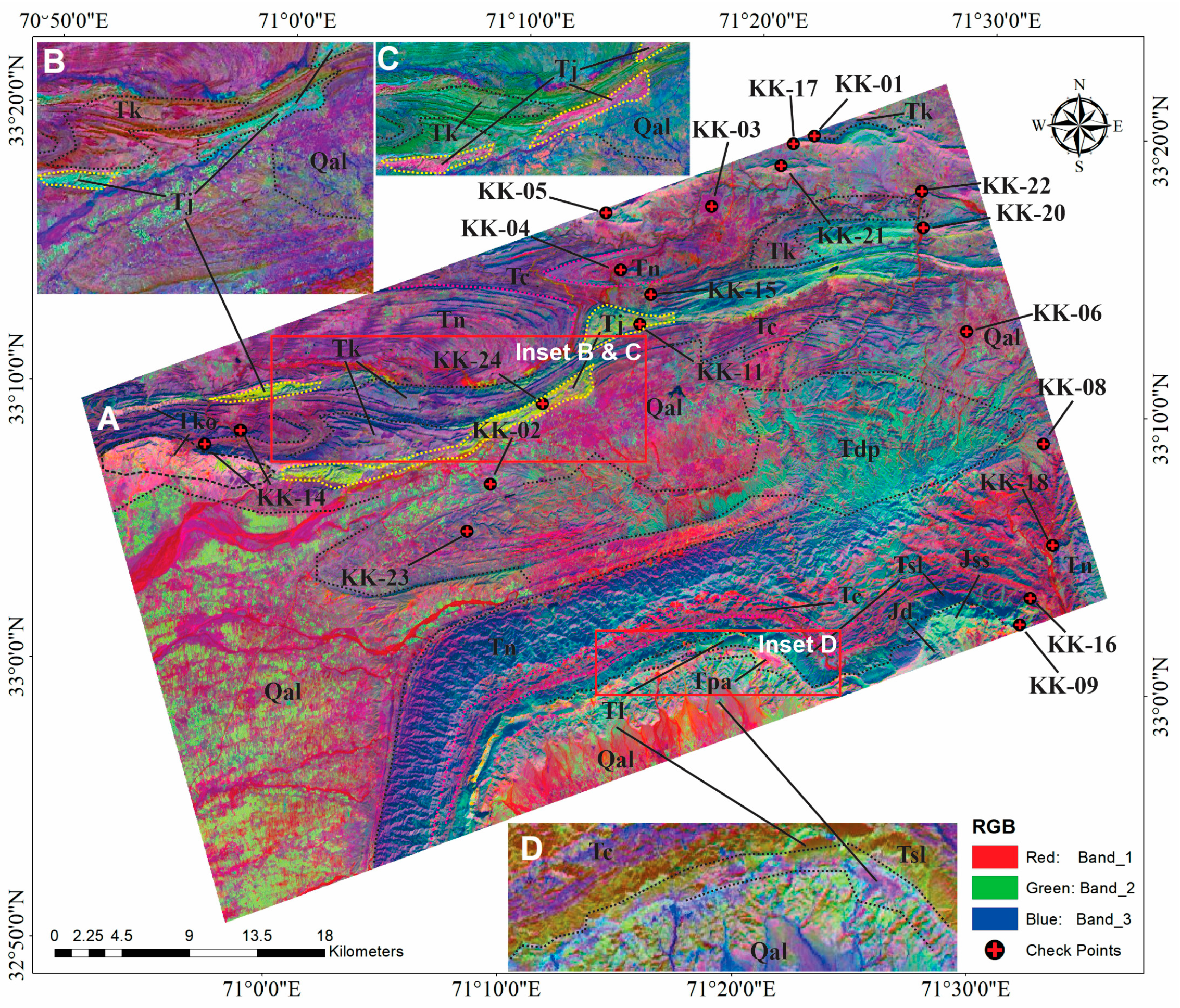
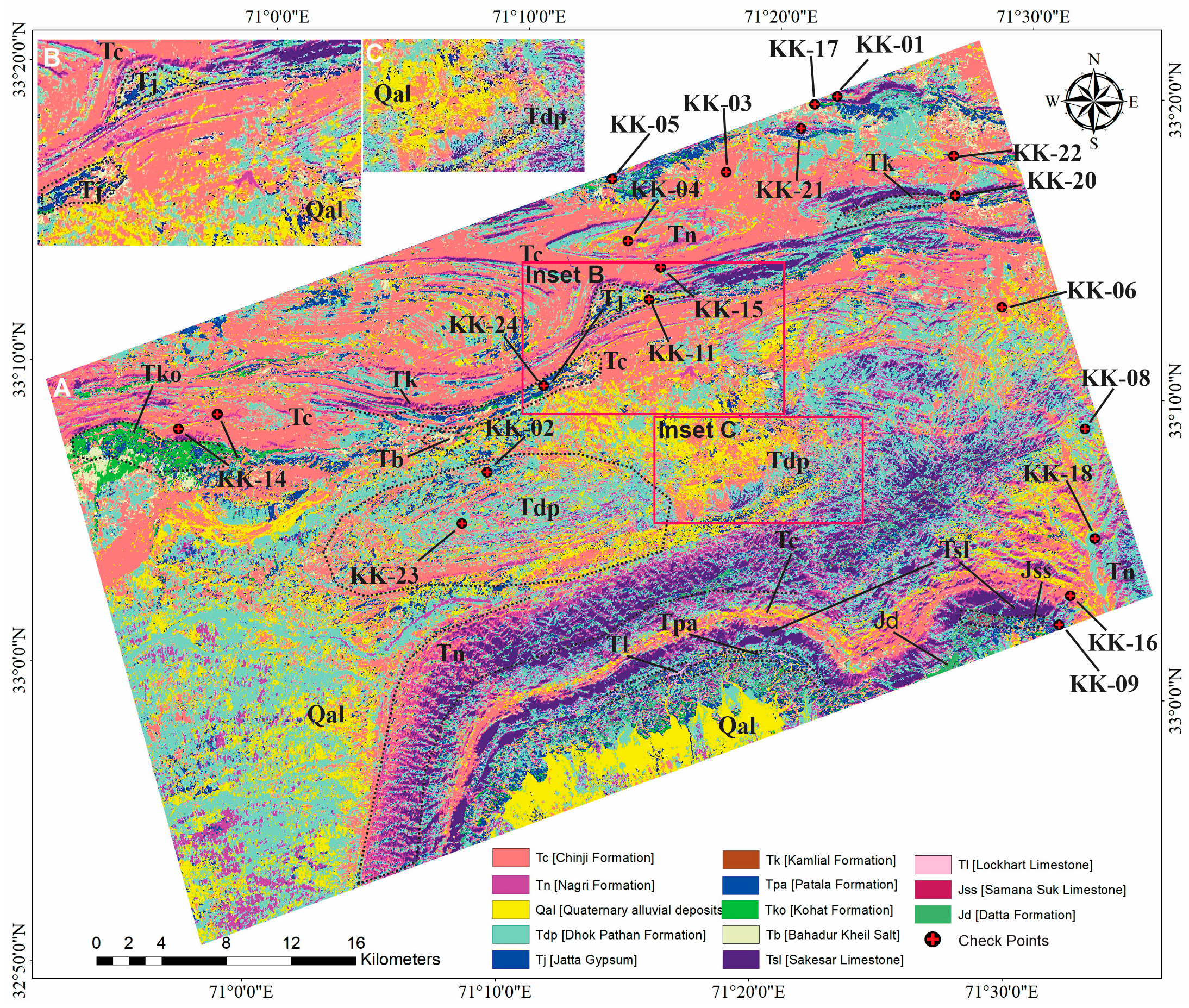
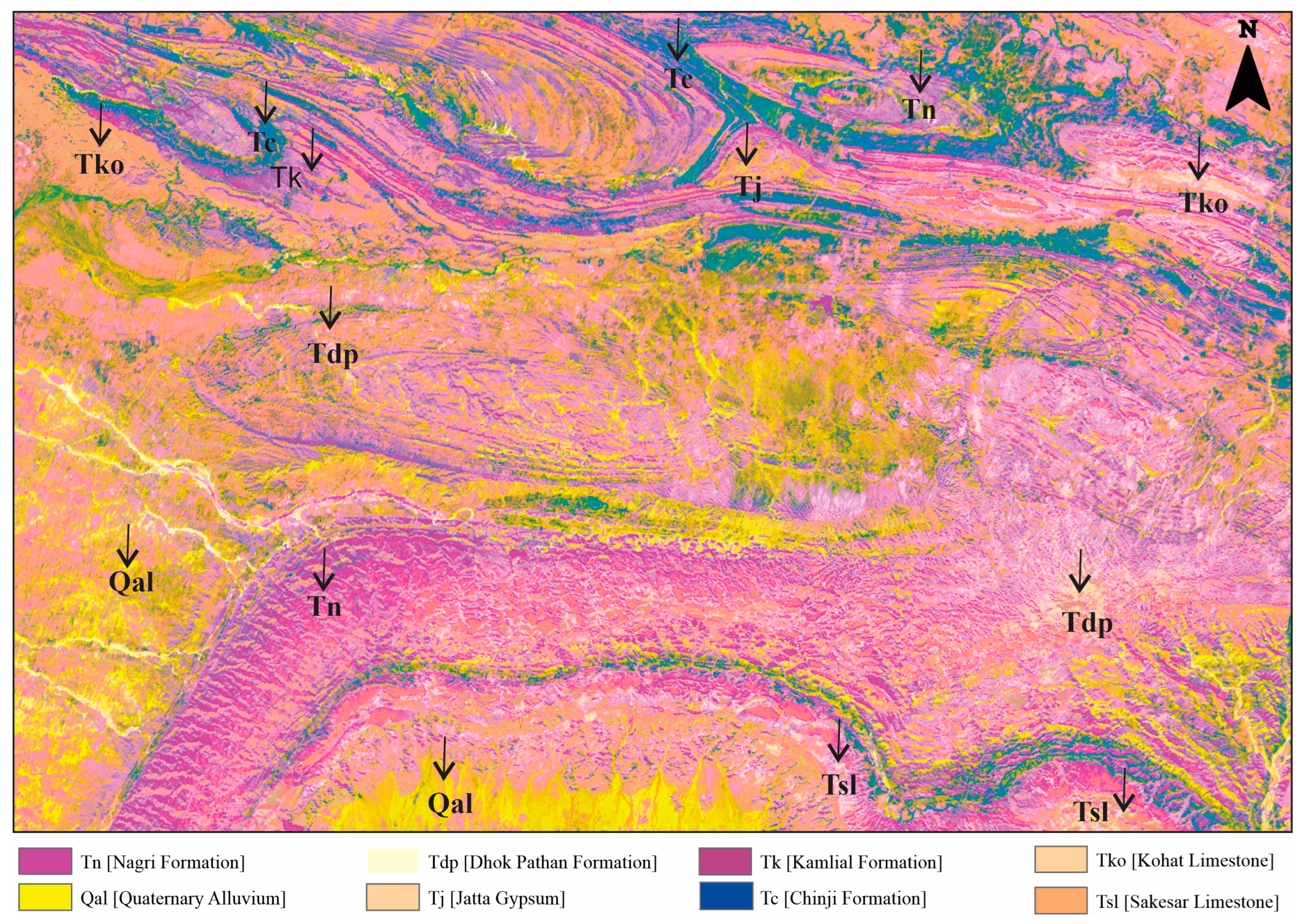
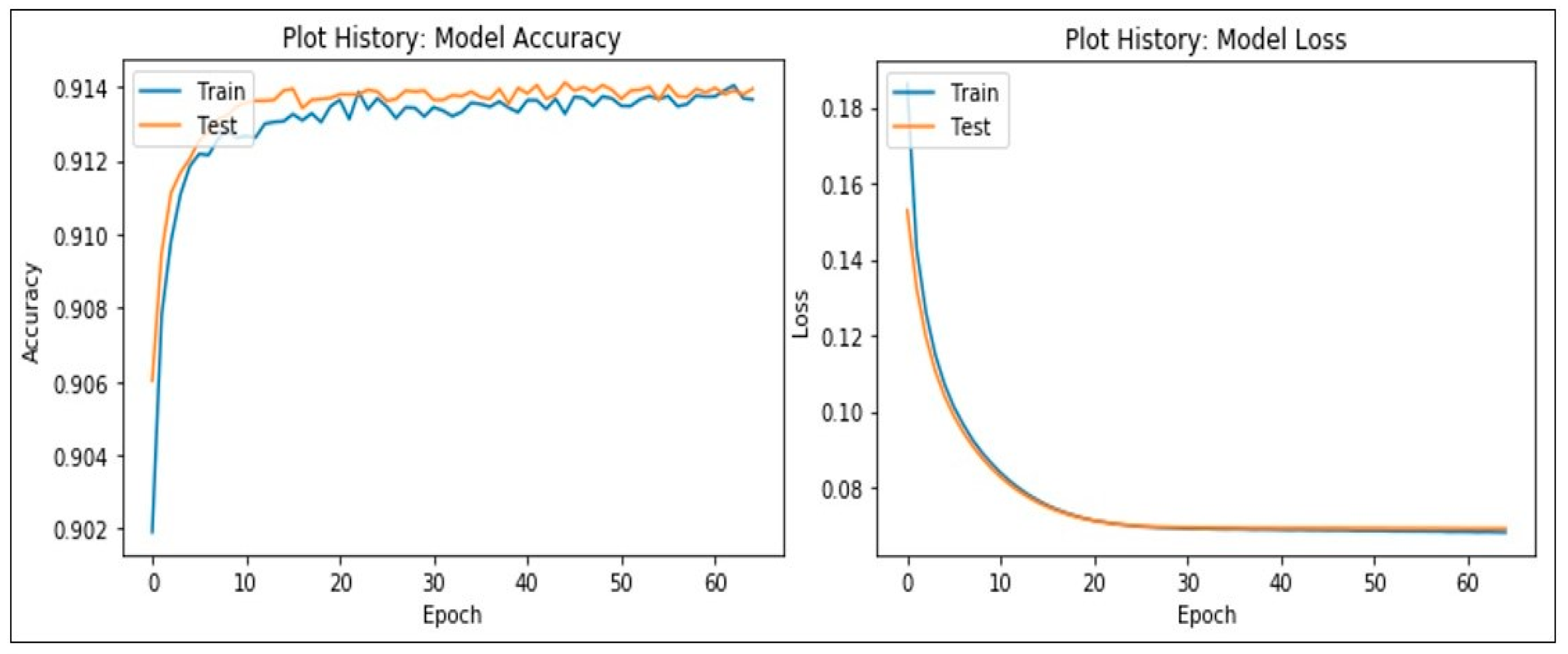
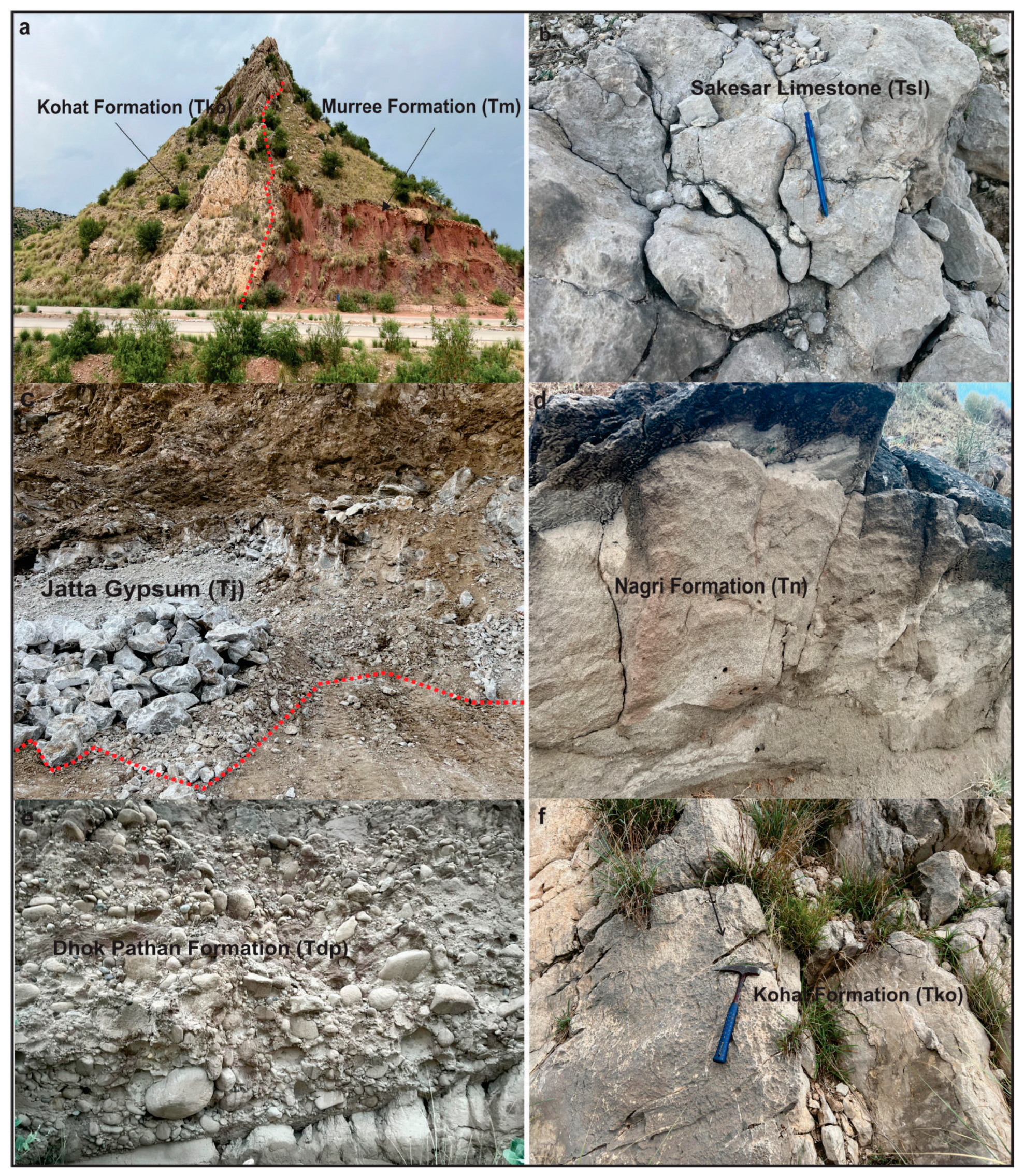

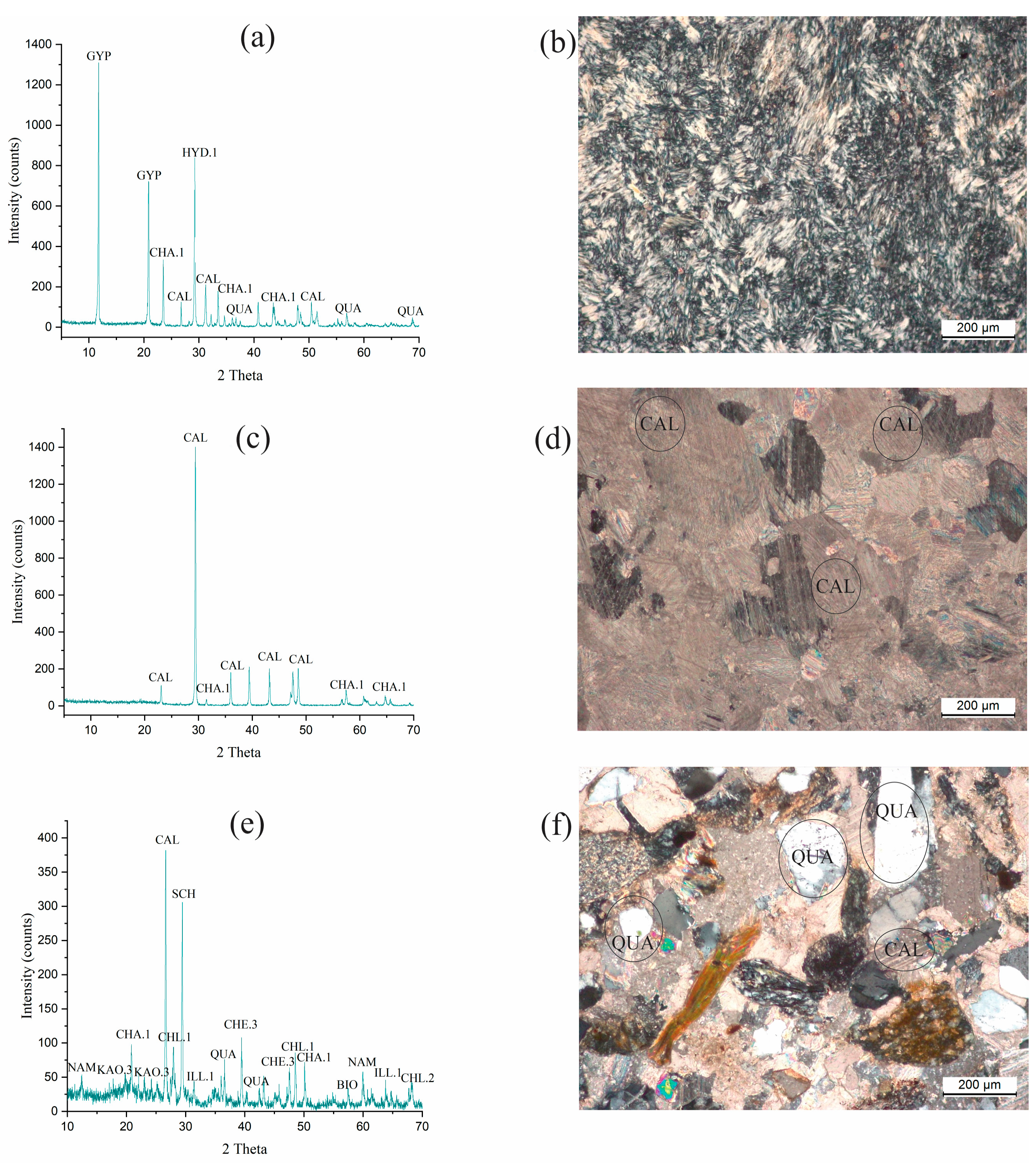
| Satellite Payloads | ZY1-02D |
|---|---|
| Launch date | 2019-09-12 |
| Orbit altitude (km) | 778 |
| Number of bands | 76 (VNIR), 90 (SWIR) |
| Spectral range (μm) | 0.4–1.0 (VNIR), 1.0–2.5 (SWIR) |
| Spectral resolution (nm) | 10 (VNIR), 20 (SWIR) |
| Spatial resolution (m) | 30 |
| Revisit period (days) | 55 |
| Swath width (km) | 60 |
| Signal-to-noise ratio (SNR) | ≥240 (0.4–0.9 μm) ≥180 (0.9–1.75 μm) ≥120 (1.75–2.50 μm) |
| Eigenvector | Band 1 | Band 2 | Band 3 | Band 4 | Band 5 | Band 6 | Band 7 | Band 8 | Band 9 | Band 10 | Variance, % |
|---|---|---|---|---|---|---|---|---|---|---|---|
| PCA1 | −0.1966 | −0.1963 | −0.1961 | −0.1960 | −0.1958 | −0.1957 | −0.1955 | −0.1953 | −0.1951 | −0.1950 | 99.97 |
| PCA2 | −0.1193 | −0.1358 | −0.1363 | −0.1340 | −0.1320 | −0.1249 | −0.1191 | −0.1130 | −0.1075 | −0.1012 | 0.020 |
| PCA3 | −0.0601 | −0.0147 | −0.0095 | −0.0129 | −0.0121 | −0.0345 | −0.0521 | −0.0721 | −0.0890 | −0.1072 | 0.002 |
| PCA4 | −0.3830 | −0.3033 | −0.2591 | −0.2204 | −0.1737 | −0.1457 | −0.1144 | −0.0872 | −0.0651 | −0.0409 | 0.000122 |
| PCA5 | 0.1662 | 0.1232 | 0.1066 | 0.0925 | 0.0733 | 0.0611 | 0.0450 | 0.0302 | 0.0161 | 0.0019 | 0.000077 |
| PCA6 | 0.8369 | −0.0844 | −0.1297 | −0.1564 | −0.1517 | −0.1498 | −0.1548 | −0.1635 | −0.1704 | −0.1613 | 0.000030 |
| PCA7 | −0.1136 | 0.0804 | 0.0598 | 0.0405 | 0.0244 | 0.0086 | 0.0005 | −0.0093 | −0.0259 | −0.0477 | 0.0000162 |
| PCA8 | 0.2319 | −0.4619 | −0.1869 | −0.0866 | −0.0196 | 0.0483 | 0.0933 | 0.1347 | 0.1804 | 0.2236 | 0.000011 |
| PCA9 | 0.0292 | −0.4789 | −0.0659 | −0.0057 | 0.0372 | 0.0829 | 0.1072 | 0.1293 | 0.1470 | 0.1653 | 0.000007 |
| PCA10 | 0.0053 | 0.1496 | −0.0532 | −0.0405 | −0.0229 | −0.0220 | −0.0277 | −0.0246 | −0.0238 | −0.0186 | 0.00003 |
| Comparison Aspect | SVM (Support Vector Machine) | SSTF (Spatial–Spectral Transformer) |
|---|---|---|
| Algorithm type | Machine learning (statistical learning) | Deep learning (transformer-based) |
| Data handling | Works well with limited labeled data | Requires a large dataset for training |
| Accuracy in the study | 89.7% | 92.1% |
| Spectral mixing | Less effective in disentangling mixed spectral signatures | Robust against spectral mixing and overlapping features |
| Spatial consideration | Primarily classifies based on per-pixel spectral features | Considers spatial relationships between neighboring pixels |
| Computational demand | Low computational cost, can be implemented on standard workstations | High computational cost, requires GPU for deep learning training |
| Interpretability | High (decision boundaries can be analyzed) | Low (black-box deep learning model) |
| Suitability for terrain | Effective in simpler geological settings with distinct units | Ideal for complex terrains with variable lithology |
| Generalization | Can be applied with different kernels for various datasets | Requires training on diverse datasets for good generalization |
| Training time | Faster compared to deep learning models | Slower due to extensive feature extraction |
| Field validation consistency | Performed well but missed finer lithological details | Matched field samples more accurately due to spectral–spatial analysis |
Disclaimer/Publisher’s Note: The statements, opinions and data contained in all publications are solely those of the individual author(s) and contributor(s) and not of MDPI and/or the editor(s). MDPI and/or the editor(s) disclaim responsibility for any injury to people or property resulting from any ideas, methods, instructions or products referred to in the content. |
© 2025 by the authors. Licensee MDPI, Basel, Switzerland. This article is an open access article distributed under the terms and conditions of the Creative Commons Attribution (CC BY) license (https://creativecommons.org/licenses/by/4.0/).
Share and Cite
Ahmad, W.; Liu, L.; Guo, Z.; Khalil, Y.S.; Islam, N.U.; Islam, F. Lithological Classification Using ZY1-02D Hyperspectral Data by Means of Machine Learning and Deep Learning Methods in the Kohat–Pothohar Plateau, Khyber Pakhtunkhwa, Pakistan. Remote Sens. 2025, 17, 1356. https://doi.org/10.3390/rs17081356
Ahmad W, Liu L, Guo Z, Khalil YS, Islam NU, Islam F. Lithological Classification Using ZY1-02D Hyperspectral Data by Means of Machine Learning and Deep Learning Methods in the Kohat–Pothohar Plateau, Khyber Pakhtunkhwa, Pakistan. Remote Sensing. 2025; 17(8):1356. https://doi.org/10.3390/rs17081356
Chicago/Turabian StyleAhmad, Waqar, Lei Liu, Zhenhua Guo, Yasir Shaheen Khalil, Nazir Ul Islam, and Fakhrul Islam. 2025. "Lithological Classification Using ZY1-02D Hyperspectral Data by Means of Machine Learning and Deep Learning Methods in the Kohat–Pothohar Plateau, Khyber Pakhtunkhwa, Pakistan" Remote Sensing 17, no. 8: 1356. https://doi.org/10.3390/rs17081356
APA StyleAhmad, W., Liu, L., Guo, Z., Khalil, Y. S., Islam, N. U., & Islam, F. (2025). Lithological Classification Using ZY1-02D Hyperspectral Data by Means of Machine Learning and Deep Learning Methods in the Kohat–Pothohar Plateau, Khyber Pakhtunkhwa, Pakistan. Remote Sensing, 17(8), 1356. https://doi.org/10.3390/rs17081356






